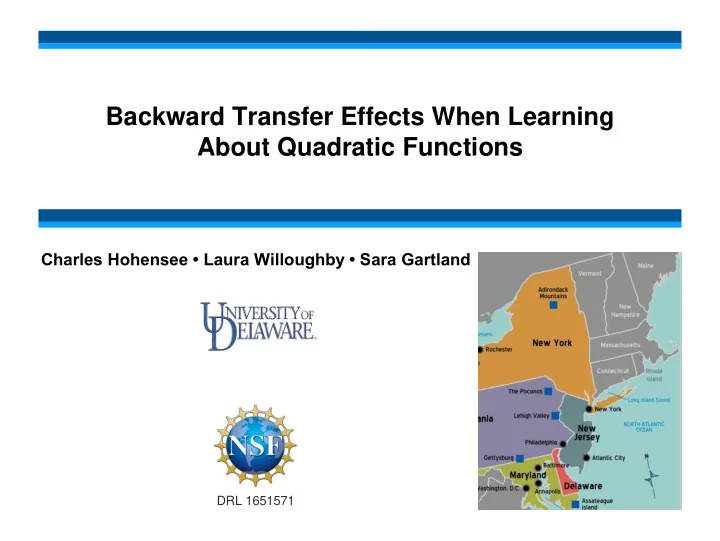

Backward Transfer Effects When Learning About Quadratic Functions Charles Hohensee • Laura Willoughby • Sara Gartland DRL 1651571
What is Backward Transfer? Context 1 Context 1 Understanding Understanding Knowledge Knowledge (Forward) Backward Transfer Transfer Context 1 Context 2 Problem Problem Concept Concept Task Task
Theoretical Grounding for Backward Transfer • We know there is a relationship between prior knowledge and new learning (e.g., Hiebert & Carpenter, 1992) • “Learning a domain of elementary mathematics or science may entail changes of massive scope…creating very large ripple effects through the system ” (Smith, diSessa, & Roschelle, 1993, p. 148, italics added)
Empirical Evidence of Backward Transfer Effects Second-Language Unintentional Cook (2003), Learning Production Weinreich (1953) Unintentional Production Researcher-Generated Hohensee (2014) Intentional Pr oduction Mathematics Teachers’ Unintentional Hohensee (2016) Observations Production
Research Question What kinds of changes in Algebra students’ previously -established ways of reasoning about linear functions are observed after students complete a quadratic functions unit with their regular mathematics teacher? Ways of Ways of Reasoning about Reasoning about Linear Functions Linear Functions Before After Quadratic Functions Unit
Methods Participants and Setting • 9th and 10th Grade Algebra Classes • Teachers = +8 years experience • Quadratic Functions curricula focus on properties of graphs and symbol manipulation Before After Intervention Quadratic • Linear Function Pre-Assessment • Linear Function Post-Assessment Functions • Clinical Semi-Structured Interviews • Clinical Semi-Structured Interviews Unit
Methods Initial Analysis • Analysis of three students’ assessments and interviews • Descriptive narratives for each response for each student • Coded each response using “partway between the a priori and inductive qualitative approaches” (Miles & Huberman, 1994, p. 61) • Identified themes • Presented themes to research team as a preliminary check
Results Changes in Ways of Reasoning about Linear Functions 1. Reasoning with and without Changes in Quantities Phillip Before Quadratics
Results Changes in Ways of Reasoning about Linear Functions 1. Reasoning with and without Changes in Quantities Phillip After Quadratics
Results Changes in Ways of Reasoning about Linear Functions 2. Correspondence View vs Covariational View of Functions Alex Before Quadratics
Results Changes in Ways of Reasoning about Linear Functions 2. Correspondence View vs Covariational View of Functions Alex After Quadratics
Summary Answering the Research Question • Quadratic functions learning activities can unintentionally influence students’ ways of reason about linear functions. • Looking at students reasoning about changes in quantities and the covariational vs correspondence view of functions seems promising. • Changes in reasoning may be unintentionally productive. Changes in reasoning may also occur that are not more or less productive. Implications for Practice • Teachers could provide students opportunities after quadratics lessons to reason in linear contexts with changes in quantities. • Teachers could emphasize the correspondence view during quadratics lessons so that they don’t lose sight of it.
Extra Slides Teacher 1 9th Grade Classroom 1: N 1 =9 High School A Teacher 2* 10th Grade Classroom 2: N 2 =27 Participants Teacher 3 9th Grade Classroom 3: N 3 =18 High School B Teacher 4 10th Grade Classroom 4: N 4 =24 N T =81
Extra Slides Context 1 Understanding Knowledge Backward Backward transfer is “the Transfer influence that constructing and subsequently generalizing new knowledge has on one’s ways Context 2 of reasoning about related Problem mathematical concepts that one Concept Task has encountered previously” (Hohensee, 2014)
Extra Slides Changes in Ways of Reasoning about Linear Functions 3. Additive vs Multiplicative Reasoning Alex Pre-Assessment
Extra Slides Changes in Ways of Reasoning about Linear Functions 3. Additive vs Multiplicative Reasoning Alex Post-Assessment
References Hiebert, J. & Carpenter, T. P. (1992). Learning and teaching with understanding. New York: Macmillan Publishing Co., Inc. Hohensee, C. (2014). Backward transfer: An investigation of the influence of quadratic functions instruction on students’ prior ways of reasoning about linear functions. Mathematical Thinking and Learning, 16(2), 135-174. Hohensee, C. (2016). Hohensee, C. (2016a). Teachers’ awareness of the relationship between prior knowledge and new learning. Journal for Research in Mathematics Education, 47 (1), 16-26. Miles, M., & Huberman, M. (1994). Qualitative data analysis. Thousand Oaks, CA: Sage Publications. Smith, J. P., diSessa, A. A., & Roschelle, J. (1993). Misconceptions reconceived: A constructivist analysis of knowledge in transition. The Journal of the Learning Sciences, 3 (2), 115-163.
Recommend
More recommend